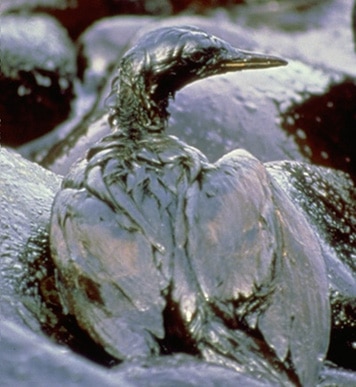The foreseeable end of vessel heavy fuel oil use in the Arctic
by John Kaltenstein, senior marine policy analyst

Donate Now!
Your contribution will benefit Friends of the Earth.
Stay Informed
Thanks for your interest in Friends of the Earth. You can find information about us and get in touch the following ways:
In January, fiery images of the Panamanian-flagged tanker Sanchi sinking in the East China Sea circulated around the world, illuminating the hazards of shipping hydrocarbons by sea. After colliding with a cargo ship, the tanker sank, releasing 111,000 tons of natural gas condensate. All 32 crew members died.
The condensate, a light and obviously volatile hydrocarbon, is the byproduct of natural gas production and less dense than seawater. After the Sanchi sank, the liquid spread out in a thin layer over the surface and, to some degree, evaporated or dissolved into the ocean.
There has never been a marine condensate spill of this magnitude before, so the near and long term environmental effects of this release remain largely unknown.
However, in addition to the highly volatile condensate, the Sanchi was carrying about 1,900 metric tons (or about 563,880 gallons) of heavy fuel oil when it sank. Salvors may attempt to extract this fuel from the vessel’s bunker tanks, which are located with the wreck in about 375 feet of water.
However, if heavy fuel oil does escape the vessel, the environmental consequences could be severe. When heavy fuel oil is spilled into seawater, the oil emulsifies, expands significantly in volume, and spreads widely.
The tar-like heavy fuel oil can coat birds and marine mammals and thereby impair the animals’ ability to maintain normal temperatures, leading to hypothermia or death.

Following the Sanchi collision, which happened approximately 160 miles off the coast of Shanghai in the East China Sea, aircraft and vessels from China, Japan, South Korea, and the United States arrived at the site within hours. The collision occurred in a fairly high-traffic shipping area, allowing for a relatively rapid response.
If this type of event had occurred in the Arctic, the ability to respond would be far more challenging. When the passenger vessel Clipper Adventurer ran aground in Coronation Gulf in the Northwest Passage in 2010, it took a Canadian Coast Guard icebreaker approximately a day and a half to reach the stranded vessel.
The presence of sea ice and harsh weather conditions in the Arctic make oil spill response and salvage efforts even more difficult. During the Arctic summer—when response ability is at its peak—oil spill control measures will be ineffective from 18% to 56% of the time.
The Arctic is home to approximately 400,000 indigenous peoples, many of whom rely on natural resources from the ocean for subsistence, so Arctic ecosystem preservation is crucial. In addition, removing heavy fuel oil—which needs to be heated in order to flow—from bunker tanks submerged in icy cold waters could be extremely difficult.
In 2015, 889 of 2,086 (42%) of the ships traveling through the Arctic used dirty heavy fuel oil, with many of the largest vessels using that fuel type. During that year, 57% of fuel used and 76% of fuel carried in the region was heavy oil.
The threat posed by heavy fuel oil in the Arctic is substantial. In fragile, ice-covered marine environments, use of this fuel by ships is a disaster waiting to happen.
The danger has been acknowledged for quite some time. The International Maritime Organization — a U.N. body charged with developing standards for international — banned its use and carriage (including as cargo) in the Antarctic Ocean in 2011.
The IMO’s recent environmental meeting in April 2018, however, significantly advanced the issue of HFO regulation in the Arctic. While work on the topic remains, including on technical details and the development of an impact assessment, the extent of support from IMO member state delegations (about 20 spoke out favorably in April) on the issue was impressive. Such support goes to show that the days of ships using dirty bunker fuel in such a pristine and vulnerable marine ecosystem are numbered.
